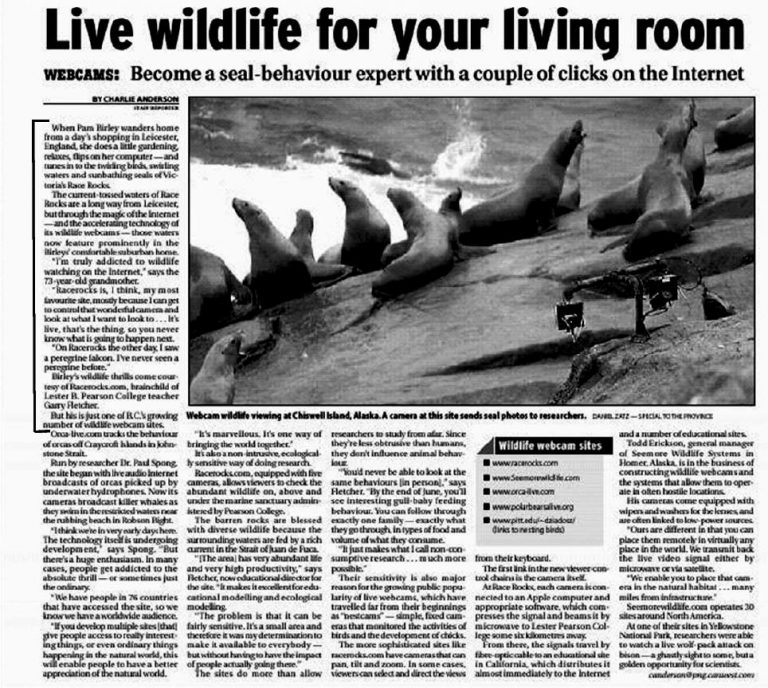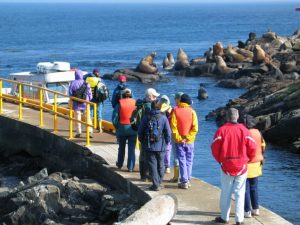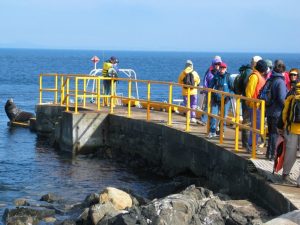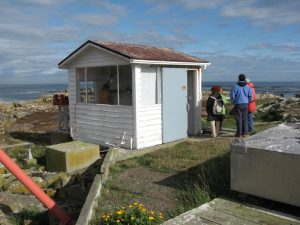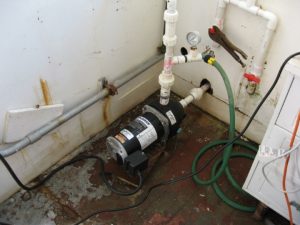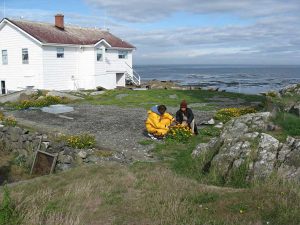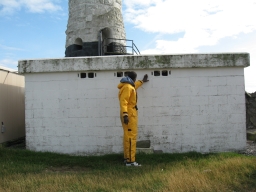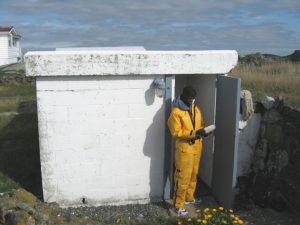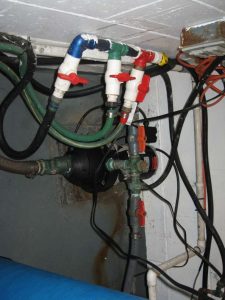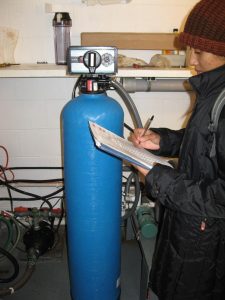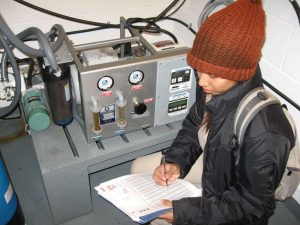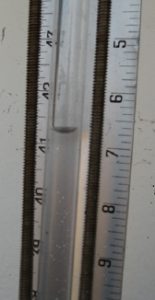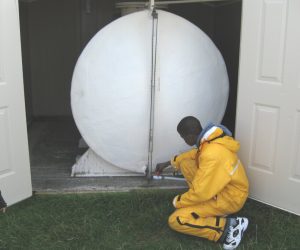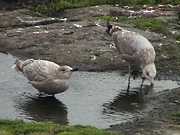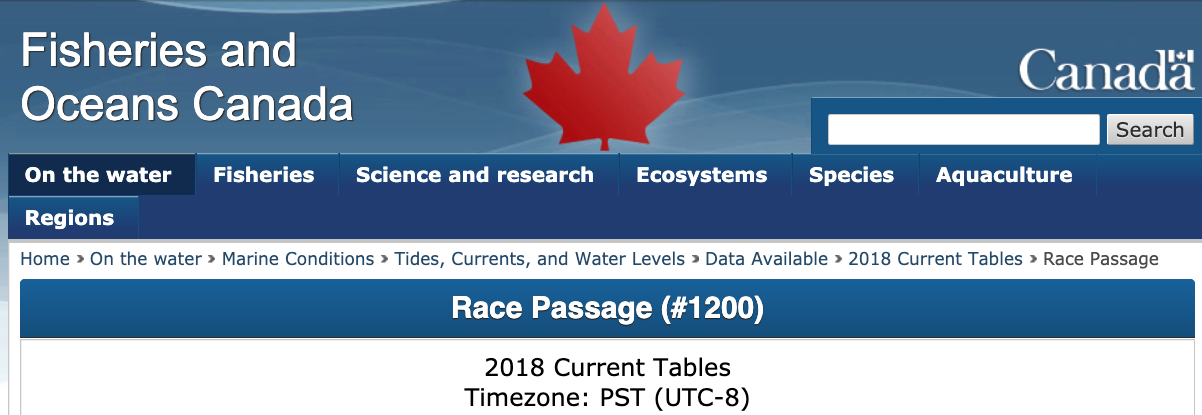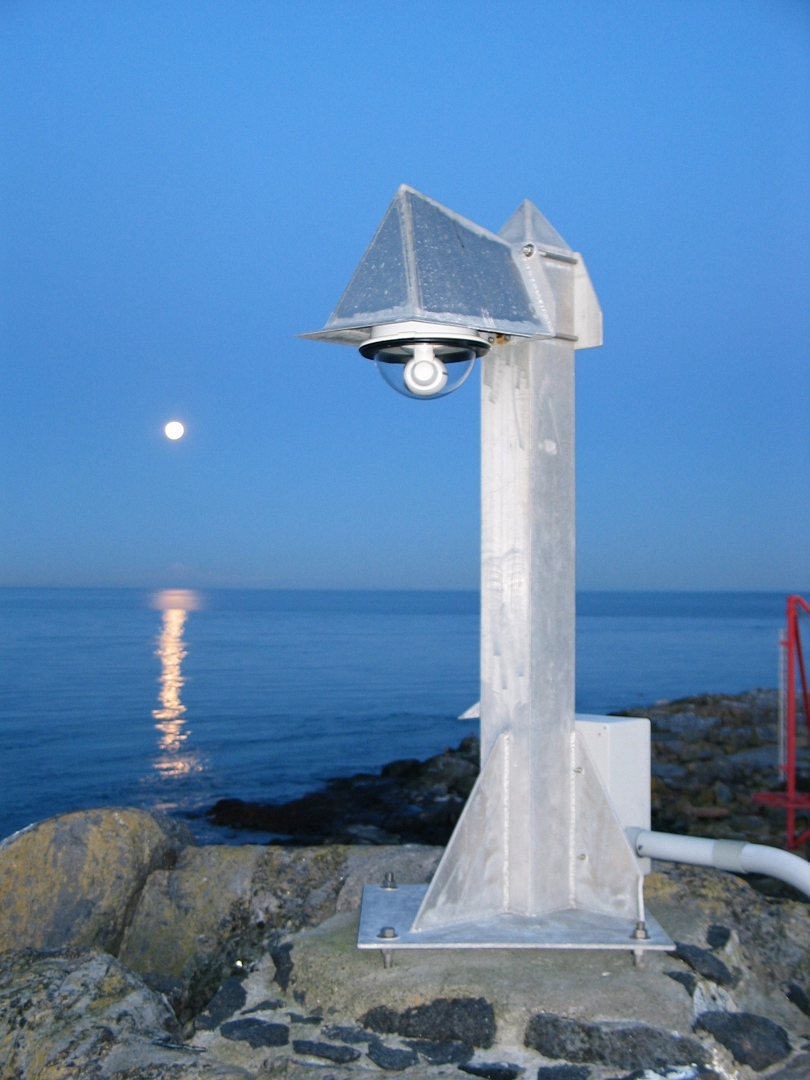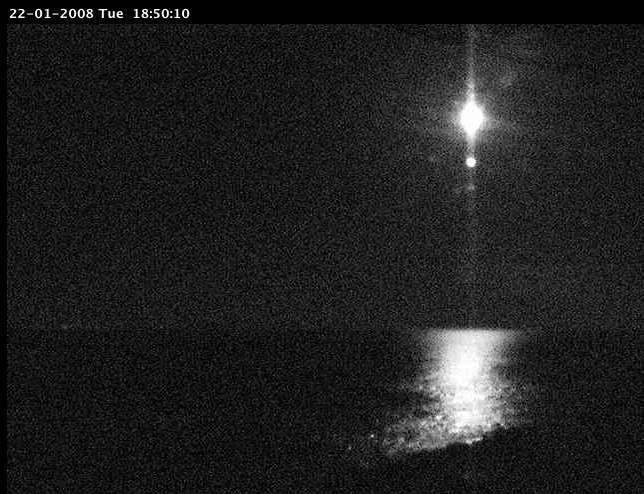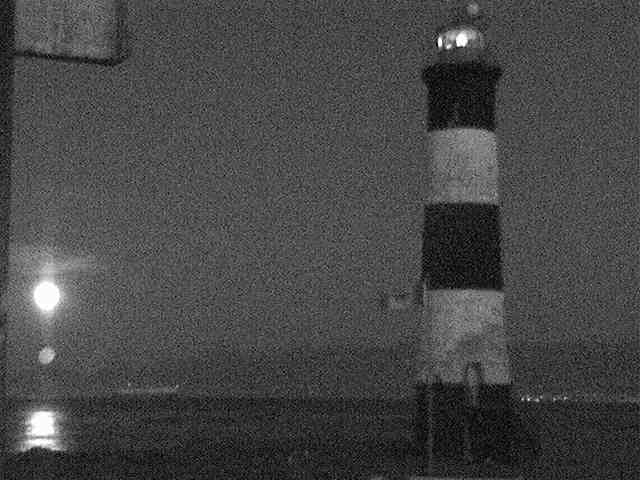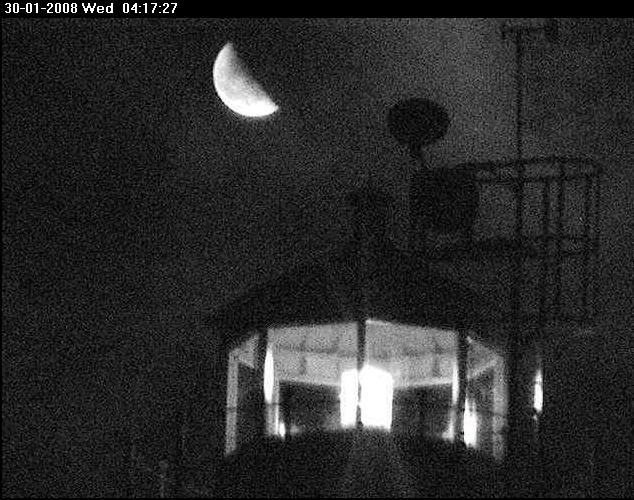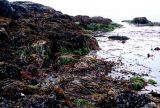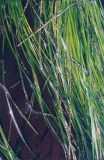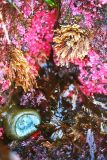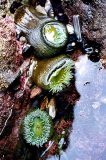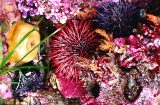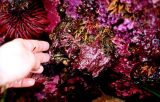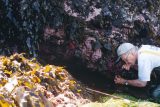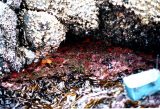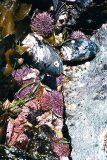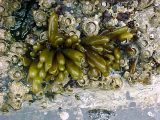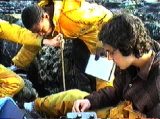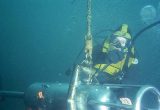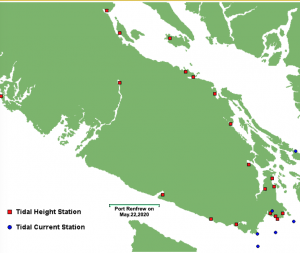| Pam Birley of Leicester England was interviewed by the Province newspaper about her wildlife viewing on racerocks.com ref: Anderson, Charlie, “Live Wildlife for your Living Room “, The Province, Vancouver, B.C. ( Sunday, Nov.21, 2004 |
Category Archives: Admin
Race Rocks Ecological Reserve: An Unusual Model of Reserve Management
Race Rocks Ecological Reserve: An Unusual Model of Reserve Management….By Garry Fletcher
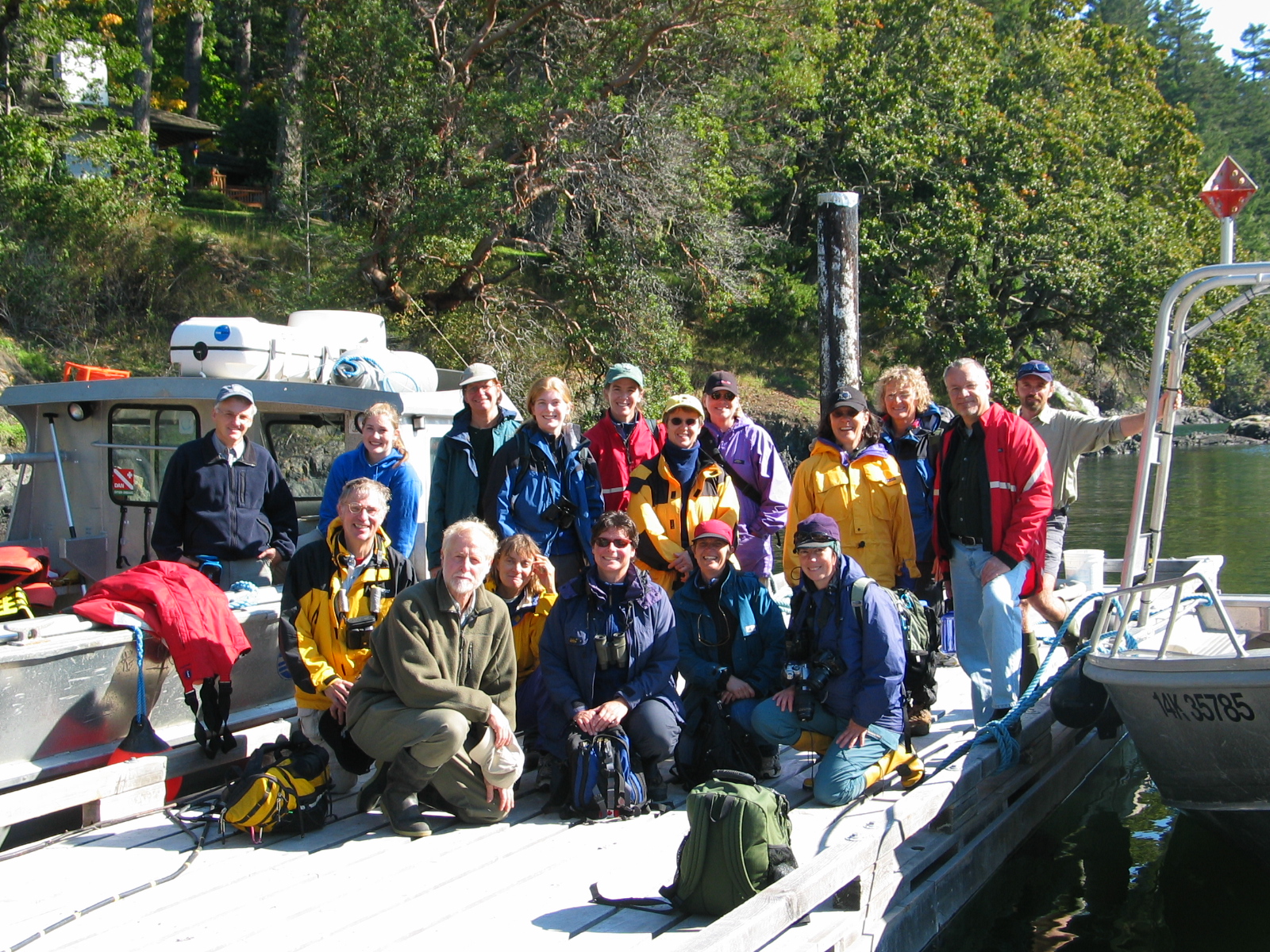 On October 3rd, this group of the Friends of Ecological Reserves made a trip to Race Rocks in the Pearson College Boats with Garry Fletcher and Chris Blondeau, Chris is the Pearson College Sea-front Coordinator and Operations Manager of Race Rocks. This fall has been remarkable in the consistently high population of Northern and California Sea Lions and high populations of seagulls and Cormorants on the islands, so it was a good time for the visit after the nesting season.
On October 3rd, this group of the Friends of Ecological Reserves made a trip to Race Rocks in the Pearson College Boats with Garry Fletcher and Chris Blondeau, Chris is the Pearson College Sea-front Coordinator and Operations Manager of Race Rocks. This fall has been remarkable in the consistently high population of Northern and California Sea Lions and high populations of seagulls and Cormorants on the islands, so it was a good time for the visit after the nesting season.
As a result of questions from members on the trip, I thought it might be useful to update everyone who is interested in the events on the reserve with the present state of the management and financing of Race Rocks. Lester Pearson College assumed the full management of the facilities and staff at Race Rocks in the fall of 1997. The light and foghorn had been automated, and the Canadian Coastguard was retiring the light keepers, Mike and Carol Slater. All the facilities except the light tower and foghorn were returned to BC Lands. An agreement was reached whereby the island was leased for long-term management and continued use for education and research by Lester Pearson College. In 2001, BC Parks was able to expand the Ecological reserve, which had previously omitted the large island with the facilities, to include all the remaining land area of Great Race Island in addition to the original 256 hectares of Islands and water to the 36 meter depth.
The Slaters were hired by Lester Pearson College to stay on as Ecological Reserve Guardians, providing security and keeping the diesel generator running, thus ensuring that the college could have full use of the other buildings and facilities on the island. In addition, the daily collection of air and sea temperature and salinity data was continued, maintaining a valuable long-term database. An anonymous donor from Ontario met operating costs for the first year. Each year after a special effort has been made by the college to secure the operating funds to carry through to keep the island open. By the year 2000, a proposal was made to the Millennium Partners Fund of Canada, to help fund the installation of Internet facilities and microwave to provide a link to the College for the transmission of Broadband Internet. A number of partners and sponsors who continue to assist are referenced on the website. Each year since, the college has had to seek funding from a number of sources to keep the island going, since government funding for parks is very hard to come by.
One of the higher costs incurred in the operation is the diesel fuel to run the island’s generators. Last year over $20,000 went into this, so it has been an aim for some time to incorporate alternate energy technology in the operation. It is with great relief that I can now tell you that our efforts are paying off as we now have a company, Clean Current Power Inc. securing the complete funding and installing at Race Rocks in the next year, an underwater tidal current generator which will have negligible negative environmental impacts. Although a research prototype, this should generate all the required electrical needs for the island. The diesel generators will become backup utilities.
BC Parks has made a good effort to help with some of the facility costs on the island. Keep in mind that most Ecological Reserves do not have dwellings and facilities such as docks and workshops, so they have provided the funds to mitigate the effects of human sewage from the two houses, with the installation of composting toilets in 2003. The Coast guard, although having no direct financial commitment, has provided technical assistance when necessary. In 2000 an Advisory Board was set up by DFO for the formation of an Official Marine Protected Area under the Oceans Act. The Ecological Reserve is still a Marine Protected Area Designate, since final treaty negotiations have put a hold on complete Marine Protected Area Status. This has meant that no federal funds are available for maintaining the Protected Area.
It is a difficult job securing at least $80,000 a year to keep the island operational. What is really needed is an endowment, and this we are determined to seek over the next few years. Keeping observers and cameras on the island has in the last few years served to keep the many users of the area accountable, so that the ecological integrity of the resource may be sustained. On the home page of racerocks.com is written: “we humans are never content just to know that a special area exists on this earth. We strive to be there, to touch, to feel, to consume. But therein lies the paradox. In so doing we can destroy the very thing we love.” The aim of the racerocks.com program has always been to make this special ecosystem available to all through the Internet. We have been fortunate to have this opportunity to establish a window into the daily lives of the creatures of a rugged marine island ecosystem. We just hope that we can continue to make the amazing life of these islands available to all. This spring with the further assistance of Apple Computer, we upgraded our computers and added a new 340 degree robotic camera which provides a much more thorough survey of many parts of the islands from your own computer.
We are grateful for any assistance in the funding of the program at Race Rocks. One can pay by cheque or credit card to The Race Rocks Operating Fund c/o Lester B. Pearson College, 650 Pearson College Drive. (250) 391-2411. A tax receipt will be provided for amounts over $25.00
This article appeared in the Winter 2004 edition of the Friends of Ecological Reserves Newsmagazine ; The LOG
Garry Fletcher (garryf(use the at sign).gmail.com) the volunteer warden for Race Rocks Ecological Reserve is the Educational Director of racerocks.com.In 2004 he retired after teaching for 36 years. The last 28 of those years have been spent in Biology, Environmental Systems and the SCUBA diving program at Lester B. Pearson College of the Pacific. Garry now continues with his work on https://www.racerocks.ca and serves as a consultant from his home in Metchosin.
racerocks.com Wins Prestigious Educational Award
|
Originally published in the Pearson College Newsletter, THE LINK September 17, 2004. Link no.66. No one who knows Garry Fletcher — and that includes almost every graduate of Pearson College — can doubt his passion for the environment. No one who has followed the development of the racerocks.com (now.ca) website, connecting the world with the marine protected area just beyond Pearson College, will be surprised that it was singled out in July for an award of excellence from the Commonwealth of Learning. The award recognizes the immense contribution of the website to non-formal distance learning. “It was an opportunity to share our good fortune with the wider educational community,” Garry has commented on the way he has beamed the rich ecosystems of Race Rocks outward electronically to museums, schools, and all individuals interested in a close look at marine life. From anywhere in the web world it is possible to watch the sealions bask and swim, to see the interaction of abundant species, and to see divers below the surface interacting with requests from children far away. “Through technology we can introduce visitors to marine ecology – without the real visits that would damage a sensitive site.” The web site racerocks.com was chosen for the following reasons by the jury: • it is fitting for a variety of clientele needs in non-formal education in the very important area of the environment • it has adopted a sound learning and instructional design, and • it uses a variety of media which can be integrated in a flexible manner according to individual learning needs and interests Garry Fletcher retired from Pearson College this summer after some thirty years of teaching Biology and Environmental Systems. He has not, however, gone far: he lives just down the road, and continues to pass through the college on the way to Race Rocks, the marine area for which he has been instrumental in gaining protected status, and for whose website he has just been highly honoured. |
http://web.archive.org/web/20041221184308/http://peernet.lbpc.ca/thelink/091704/06racerck.html
Eileen Dombrowski
September 17, 2004. Link no.66
Commonwealth Of Learning Announces 2004 Award winners.
EXCELLENCE IN DISTANCE EDUCATION AWARDS
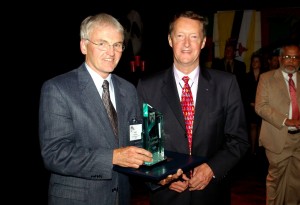 Garry Fletcher receives an award from Sir John Daniel * for the website “racerocks.com” on behalf of Lester B. Pearson College. A Gala Awards banquet was held to announce the 2004 recipients of the Excellence in Distance Education Awards (EDEA).
Garry Fletcher receives an award from Sir John Daniel * for the website “racerocks.com” on behalf of Lester B. Pearson College. A Gala Awards banquet was held to announce the 2004 recipients of the Excellence in Distance Education Awards (EDEA).
*(Sir John Daniel – President of the Commonwealth of Learning) Further information: http://www.col.org/edea
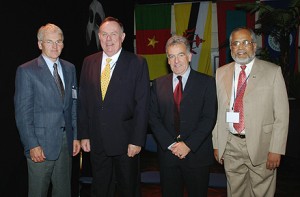 The third EDEA were conferred at the third Pan-Commonwealth Forum on Open Learning in Dunedin New Zealand, 6 JULY 2004: The photo shows- left to right: Garry Fletcher, for Category B. Dr. Thomas Webster (U. of Papua New Guinea) and Chris Baker (the Open University, Gt Britain) for category A, and Prof Mohan Menon ( Chair of Selection Committee)
The third EDEA were conferred at the third Pan-Commonwealth Forum on Open Learning in Dunedin New Zealand, 6 JULY 2004: The photo shows- left to right: Garry Fletcher, for Category B. Dr. Thomas Webster (U. of Papua New Guinea) and Chris Baker (the Open University, Gt Britain) for category A, and Prof Mohan Menon ( Chair of Selection Committee)
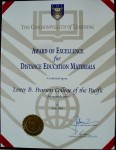 |
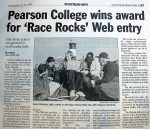 |
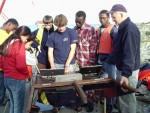 |
| The Diploma for the Excellence in Distance Education Award | Coverage of COL Award in Goldstream Gazette | Race Rocks as an example of Distance Education and Environmental Stewardship |
FROM THE “2004 CITATIONS”
COL award for excellence in distance education materials under category B: multimedia materials supporting non-formal education is awarded to Lester B. Pearson College, Victoria, Canada for its on-line materials “Racerocks.com”. We recommend this multi-media material for the award because:
it is fitting for a variety of clientele needs in non-formal education in the very important area of the environment
it has adopted a sound learning and instructional design, and
it uses a variety of media which can be integrated in a flexible manner according to individual learning needs and interests
An attractive, well-laid out site with a plethora of resources including quality content and activities providing a virtual tour of the ecosystem without actually being there. The website provides a variety of activities and resources for students and teachers at different levels, especially those in middle and high schools. The site has been designed to provide images to those who have slow computer and/or network connections thereby increasing the accessibility to the site. It enables learners to interact with a sensitive environmental area without affecting it. The nature of materials and their presentation is such that learners may either be guided to work through the site in a systematic or structured manner or they can proceed randomly, yet still learn something. It includes both current and archived material. Students are able to leave behind information for others to use and can take ownership of their learning. The topic covered by the site is and will continue to be of interest to a wide variety of people who want to learn about aquatic life and the environment.
Mr. President I ask you to confer the excellence in distance education materials award on the Lester B. Pearson College of the Pacific, British Columbia, Canada. Mr. Garry Fletcher will accept the award on behalf of the College.
Speaker: Dr. Mohan Menon
> Commonwealth of Learning (COL)
> Suite 600 – 1285 West Broadway, Vancouver, BC V6H 3X8 CANADA
> COL is an intergovernmental organisation created by Commonwealth Heads of Government to encourage the development and sharing of open learning and distance education knowledge, resources and technologies.
camera work
2004-06-17 Garry and Scot out working on cameras. Chris and helpers out delivering fuel. Carol or Mike’
David Grierson broadcasts CBC radio from Race Rocks
On June 8, 2004, we were fortunate to have David Grierson doing the CBC morning show
“On The Island ” broadcast live from Race Rocks.
We were saddened to hear of his death from a heart attack in November of 2004.
Water Supply: The Desalinator System at Race Rocks
Race Rocks ecological Reserve functions as an isolated system. Fresh water for human use may only be obtained by processing sea water through the desalinator. Energy is generated through solar panels and backup generators. The desalinator depends on these sources of energy to function. The more efficient the desalinator, the less energy is used. The students take us through the process:
- Just over the bank from the winch house is the seawater intake for the desalinator
- A line was concreted through the intertidal, and this pump in the winch house draws up the seawater and sends it over to the storage cistern.
- The concrete storage cistern is what used to be the main cistern to collect seawater from the roof of the light keepers residence. It is gradually developing a “green roof” with a covering of Sedum.
- In the 1970’s, this concrete block bomb-shelter or “Diefenbunker” was conve
- Entrance to the room. The Marine Protected Area Guardians who live on the island look after this equipment and start it up occasionally in order to replenish the water storage tank.
- The hoses and taps control the flow of water into and out of the desalinator.
- The desalinator is capable of processing 0.25 Gallons of salt water per minute on 220V. This coarse filter removes the plankton and sediments.
- The desalinator is the type used on boats where people live-aboard at sea. It contains membranes in the filters that allow fresh water to pass through at a pressure of 800 PSI.
- The water that does not go through the osmosis process is flushed back out to the sea down through a drainage hose. After passing through the desalinator, the fresh water is pumped back outside to the insulated water storage tank in the shed on the left where it is stored. The water that does not go through the osmosis process is flushed back out to the sea down through a drainage hose.
- and the only other source of fresh water on the island.. after a rainstorm
The Tidal Cycle at Race Rocks and the Abiotic Effects of Tides
At Race Rocks we have a tidal range of about 3 metres.
For tidal Level predictions , from the closest station at Pedder Bay see this link
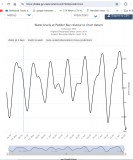 https://tides.gc.ca/en/stations/07080/predictions
https://tides.gc.ca/en/stations/07080/predictions
The link below is for the Race Passage Current tables. .. See this file for the result of original work done by Pearson College Divers assisting the Institute of Ocean Sciences in the deployment of the current meter to gather a year’s worth of data from which these tables are constructed.
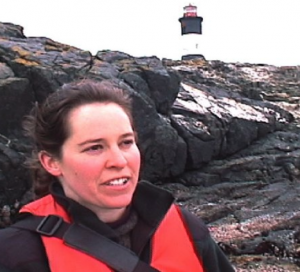 Marine Science teacher at Pearson College Laura Verhegge was interviewed on CBC radio about what was a “Negative tide”. Listen below.
Marine Science teacher at Pearson College Laura Verhegge was interviewed on CBC radio about what was a “Negative tide”. Listen below.
The role of the moon is a major factor in determining the rise and fall of the tides.The view of it from Race Rocks in a full sky is often stunning.
- photo of camera 5 and the moonrise -G.Fletcher photo
- Pam Boirley took these shots from her home in England using camera 5
And of course the other component causing tides is the sun. See this file for Solar energy records for Race Rocks .
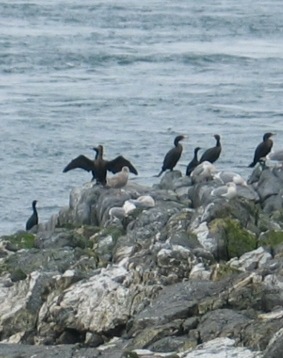 See this file for the Abiotic Effect of Solar energy on Organisms at Race Rocks
See this file for the Abiotic Effect of Solar energy on Organisms at Race Rocks
THE ABIOTIC EFFECTS OF TIDAL LEVEL CHANGES:
The rich variety of life in the intertidal zones of Race Rocks provide habitat for many animals which have adapted to living part of their life exposed . “ANITA’S ISLAND” on the West side of Great Race Rocks provides an excellent example, in the month of June when the tidal level often drops below zero datum so one can really appreciate the effects of the daily changing tidal levels on intertidal life. This island is actually a peninsula which you can walk out onto when the tides drop to -0.0m, but is totally submerged at high tide, (around 2.6 meters). You can often see the top of it from remote camera1 ( It looks black because it is covered with mussels.)
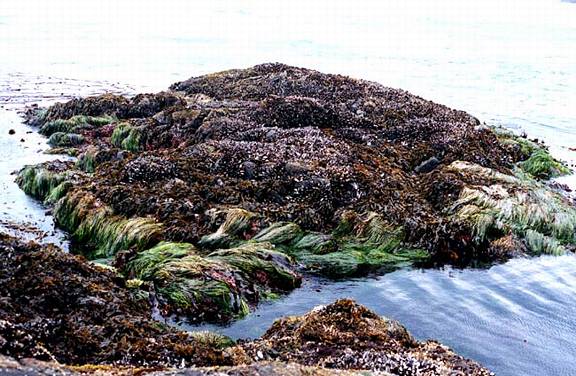 For several years in the 1990s we did research with Dr. Anita Brinckmann-Voss on these low tides in June. We only had a half hour or so until the isthmus joining the island to Great Race Island was flooded however. Each year that we went out, Anita found a great many of the hydroid samples from which she identified for the Ecological Reserve.
For several years in the 1990s we did research with Dr. Anita Brinckmann-Voss on these low tides in June. We only had a half hour or so until the isthmus joining the island to Great Race Island was flooded however. Each year that we went out, Anita found a great many of the hydroid samples from which she identified for the Ecological Reserve.
- The intertidal zone on the West side of Great Race Rocks as viewed and photographed on June 12, 1999 at a minus 0.1 tide. The predominant macroalgae is Hedophylum sp. although immature bull kelp (Nereocystis luetkeana) is also anchored in this zone close to the shore
- Small pink dots of a Melobesia mediocris, a calcareous pink encrusting algae which grows as an epiphyte on the leaves of surf grass
- Just below the green fringe of surf grass, Phyllospadix scouleri, pink hydrocorals and other hydroids such as this Abietinaria amphora survive the current and wave swept zone.
- The hydroid Aglaophemia latirostris with an Intertidal Anemone
- Other Cnidarians such as the green anemone, Anthopleura xanthogrammica, are found in the low intertidal area. These large anemone with symbiotic algae are also found in the surge channel on the south-west corner. The knife placed in the picture for scale measures 10cm in length.
- Giant red urchins Strongylocentrotus franciscanis live here at the upper limits of their range and the purple urchin, Strongylocentrotus purpuratus also inhabits a narrow band in this area.
- A giant barnacle, Balanus nubilus plays host to a colony of Symplectoscyphus turgidus ( formerly Sertularella turgida) . Hydrocoral, (Allopora sp. ) encrusts much of the substrate
- Two of the small caves at this level yield a variety of invertebrates. The ceilings of these caves usually support a variety of hydroids
- The floor of this cave on the south-west corner is covered with the red encrusting sponge, Ophlitaspongia
- Here on the small island, the purple urchins reside in a crevasse next to the mussle Mytilus californianus.
Other tidal heights from along the coast of Vancouver Island and British Columbia An interesting exercise is to compare the tidal heights at several locations around Vancouver Island. There is a significant difference, with times as well as tidal ranges varying depending where the station is located. There are many factors which determine tide levels, the most obvious being the stages of the moon and the position of the sun, but here you can see that geography has a major role to play as well. |
|||||||||||
APPLE : Partnership with racerocks.com
ARCHIVE: It is important to recognize that the early innovations in internet technology at Race Rocks were made possible by the cooperation of a number of partners and sponsors . Apple was one of the important partners in collaboration for this educational application of the internet for the conservation of a sensitive ecosystem by promoting the availability of its unique ecological features to the world.
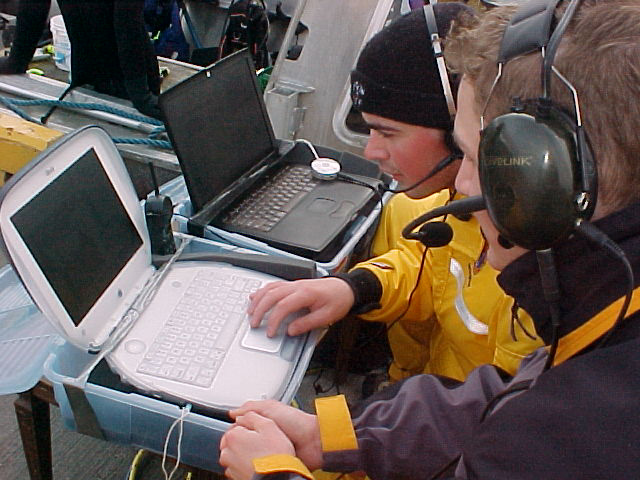 In June 2000, Apple first became a sponsor when APPLE CANADA recognized the significance of our project and loaned us a new Powerbook G3 500 for the two weeks of mobile webcasts in June 2000.
In June 2000, Apple first became a sponsor when APPLE CANADA recognized the significance of our project and loaned us a new Powerbook G3 500 for the two weeks of mobile webcasts in June 2000.
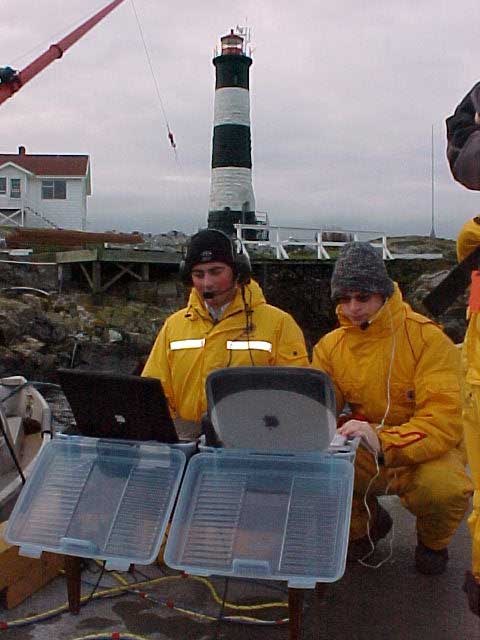 As a result of that initial support, Apple Canada sent us the same computer for our project in July 2000. At the New York MacWorld Conference in July, our presentation of a live underwater webcast from Race Rocks prompted an offer from The APPLE LEARNING INTERCHANGE for a partnership. The result was that the QuickTime live video streams were hosted by the Apple Learning Interchange over the Akamai Internet distribution network. We are extremely grateful to APPLE for this generous support. Live video streams have now been operating since the summer of 2000 thanks to tis initial support.
As a result of that initial support, Apple Canada sent us the same computer for our project in July 2000. At the New York MacWorld Conference in July, our presentation of a live underwater webcast from Race Rocks prompted an offer from The APPLE LEARNING INTERCHANGE for a partnership. The result was that the QuickTime live video streams were hosted by the Apple Learning Interchange over the Akamai Internet distribution network. We are extremely grateful to APPLE for this generous support. Live video streams have now been operating since the summer of 2000 thanks to tis initial support.
In March of 2001, APPLE Canada came to our assistance again with the generous
donation of a G4 Titanium PowerBook. We used this for our mobile webcasts and
for the creation of new archived video clips using the iMovie software.
We must also acknowledge the commitment of the Apple representative Keith Mitchell who worked out of the offices in Texas and was also able to visit us to see the operation of our system at Race Rocks.
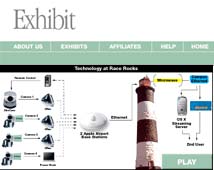 In June of 2002, The APPLE LEARNING INTERCHANGE opened its new gallery of featured exhibits and racerocks.com was included on the ALI website as one of their exhibits.
In June of 2002, The APPLE LEARNING INTERCHANGE opened its new gallery of featured exhibits and racerocks.com was included on the ALI website as one of their exhibits.
In January of 2004, The Apple Learning Interchange upgraded the three computers and the Wireless Airports and they also assisted us with the purchase of a new Remote Control camera. We now have the equipment installed and providing improved Live Streaming Images as of the spring of 2004.
In 2004, three APPLE eMacs were supplied to webcast from cameras 1, 2 and 5. Webcasting from these cameras used QuickTime Broadcaster.
Clean Current Presentation on Race Rocks as Possible Demonstration site
This PDF is of a presentation by the staff of Clean Current Power Systems Incorporated that was given to the BC Ministry of Land water and Air Protection and Fisheries and Oceans Canada in May of 2004 to give a background to the Tidal Current Energy proposal and to answer the question ” Does Tidal Turbine Technology fit the Management Plans for Race Rocks Ecological reserve? ”
See the PDF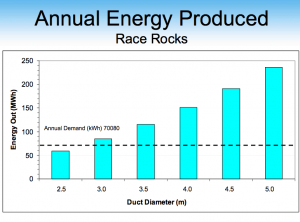 :Race Rocks Tidal Generator
:Race Rocks Tidal Generator

